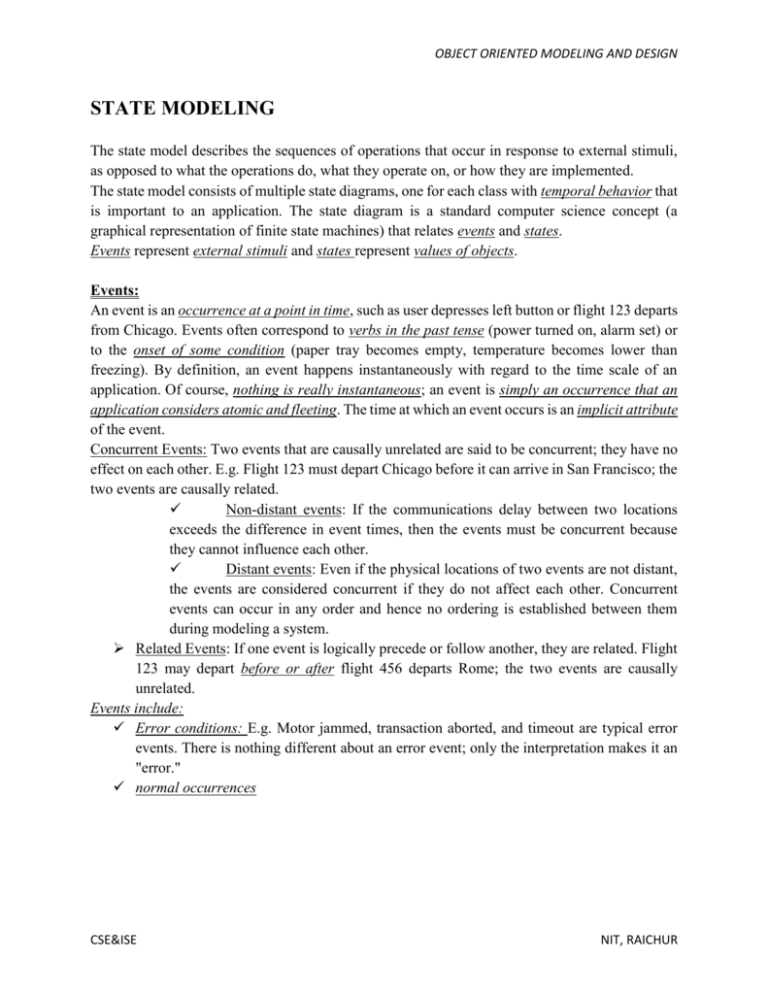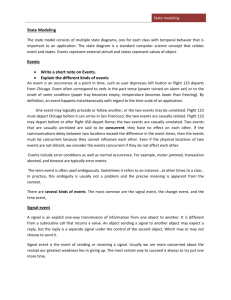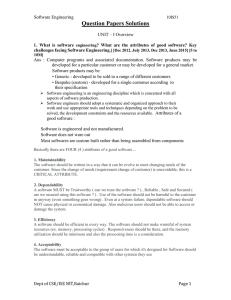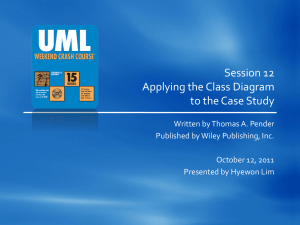events distant
advertisement

OBJECT ORIENTED MODELING AND DESIGN STATE MODELING The state model describes the sequences of operations that occur in response to external stimuli, as opposed to what the operations do, what they operate on, or how they are implemented. The state model consists of multiple state diagrams, one for each class with temporal behavior that is important to an application. The state diagram is a standard computer science concept (a graphical representation of finite state machines) that relates events and states. Events represent external stimuli and states represent values of objects. Events: An event is an occurrence at a point in time, such as user depresses left button or flight 123 departs from Chicago. Events often correspond to verbs in the past tense (power turned on, alarm set) or to the onset of some condition (paper tray becomes empty, temperature becomes lower than freezing). By definition, an event happens instantaneously with regard to the time scale of an application. Of course, nothing is really instantaneous; an event is simply an occurrence that an application considers atomic and fleeting. The time at which an event occurs is an implicit attribute of the event. Concurrent Events: Two events that are causally unrelated are said to be concurrent; they have no effect on each other. E.g. Flight 123 must depart Chicago before it can arrive in San Francisco; the two events are causally related. Non-distant events: If the communications delay between two locations exceeds the difference in event times, then the events must be concurrent because they cannot influence each other. Distant events: Even if the physical locations of two events are not distant, the events are considered concurrent if they do not affect each other. Concurrent events can occur in any order and hence no ordering is established between them during modeling a system. Related Events: If one event is logically precede or follow another, they are related. Flight 123 may depart before or after flight 456 departs Rome; the two events are causally unrelated. Events include: Error conditions: E.g. Motor jammed, transaction aborted, and timeout are typical error events. There is nothing different about an error event; only the interpretation makes it an "error." normal occurrences CSE&ISE NIT, RAICHUR OBJECT ORIENTED MODELING AND DESIGN Kinds of events: Following are the most common events. Signal Event: A signal is an explicit one-way transmission of information from one object to another. It is different from a subroutine call that returns a value. An object sending a signal to another object may expect a reply, but the reply is a separate signal under the control of the second object, which may or may not choose to send it. A signal event is the event of sending or receiving a signal. Usually, event receiving a signal is most significant, because it causes effects in the receiving object. Difference between signal and signal event: A signal is a message between objects while a signal event is an occurrence in time. Every signal transmission is a unique occurrence, but they can be grouped into signal classes and give each signal class a name to indicate common structure and behavior. E.g. UAflight 123 departs from Chicago on January 10, 1991 is an instance of signal class FlightDeparture. Some signals are simple occurrences, but most signal classes have attributes indicating the values they convey. E.g. FlightDeparture has attributes airline, flightNumber, city, and date. The UML notation is the keyword signal in guillemets (« »)above the signal class name in the top section of a box. The second section lists the signal attributes. Change Event: A change event is an event that is caused by the satisfaction of a Boolean expression. The intent of a change event is that the expression is continually tested-whenever the expression changes from false to true, the event happens. The UML notation for a change event is the keyword when followed by a parenthesized Boolean expression. E.g. Figure shows several examples of change events. CSE&ISE NIT, RAICHUR OBJECT ORIENTED MODELING AND DESIGN Time Event: A time event is an event caused by the occurrence of an absolute time or the elapse of a time interval. UML notation for an absolute time is the keyword when followed by a parenthesized expression involving time. The notation for a time interval is the keyword after followed by a parenthesized expression that evaluates to a time duration. States: A state is an abstraction of the values and links of an object. Sets of values and links are grouped together into a state according to the gross behavior of objects. E.g. The state of a bank is either solvent or insolvent, depending on whether its assets exceed its liabilities. States often correspond to verbs with a suffix of "ing" (Waiting, Dialing) or the duration of some condition (Powered, BelowFreezing). UML notation for a state: -a rounded box containing an optional state name. Convention is to list the state name in boldface, center the name near the top of the box, and capitalize the first letter. A state specifies the response of an object to input events. All events are ignored in a state, except those for which behavior is explicitly prescribed. The response may include the invocation of behavior or a change of state. E.g. If a digit is dialed in state Dialtone, the phone line drops the dial tone and enters state Dialing; if the receiver is replaced in state Dialtone, the phone line goes dead and enters state Idle. There is certain symmetry between events and states as figure illustrates. CSE&ISE NIT, RAICHUR OBJECT ORIENTED MODELING AND DESIGN Events represent points in time; states represent intervals of time. A state corresponds to the interval between two events received by an object. E.g. After the receiver is lifted and before the first digit is dialed, the phone line is in state Dialtone. The state of an object depends on past events, which in most cases are eventually hidden by subsequent events. E.g. Events that happened before the phone is hung up do not affect future behavior; the Idle state "forgets" events received prior to the receipt of the hang up signal. Both events and states depend on the level of abstraction. E.g. A travel agent planning an itinerary would treat each segment of a journey as a single event; a flight status board in an airport would distinguish departures and arrivals; an air traffic control system would break each flight into many geographical legs. Various ways of characterizing a state: Figure shows for the state Alarmringing on a watch. The state has a suggestive name and a natural-language description of its purpose. The event sequence that leads to the state consists of setting the alarm, doing anything that doesn't clear the alarm, and then having the target time occur. A declarative condition for the state is given in terms of parameters, such as current and target time; the alarm stops ringing after 20 seconds. Finally, a stimulus-response table shows the effect of events current time and button pushed, including the response that occurs and the next state. The different descriptions of a state may overlap. Like objects links can have state. As a practical matter, it is generally sufficient to associate state only with objects. Transitions and Conditions: A transition is an instantaneous change from one state to another. E.g. When a called phone is answered, the phone line transitions from the Ringing state to the Connected state. The transition is said to fire upon the change from the source state to the target state. CSE&ISE NIT, RAICHUR OBJECT ORIENTED MODELING AND DESIGN The origin and target of a transition usually are different states, but may be the same. A transition fires when its event occurs (unless an optional guard condition causes the event to be ignored). The choice of next state depends on both the original state and the event received. An event may cause multiple objects to transition; from a conceptual point of view such transitions occur concurrently. A guard condition is a Boolean expression that must be true in order for a transition to occur. E.g. A traffic light at an intersection may change only if a road has cars waiting. A guarded transition fires when its event occurs, but only if the guard condition is true. E.g. "when you go out in the morning (event), if the temperature is below freezing (condition), then put on your gloves (next state)." A guard condition is checked only once, at the time the event occurs, and the transition fires if the condition is true. If the condition becomes true later, the transition does not then fire. Note that a guard condition is different from a change event - a guard condition is checked only once while a change event is, in effect, checked continuously. Figure shows guarded transitions for traffic lights at an intersection. One pair of electric eyes checks the north-south left turn lanes; another pair checks the east-west turn lanes. If no car is in the north-south and/or eastwest turn lanes, then the traffic light control logic is smart enough to skip the left turn portion of the cycle. The UML notation for a transition is a line from the origin state to the target state. An arrowhead points to the target state. The line may consist of several line segments. An event may label the transition and be followed by an optional guard condition in square brackets. By convention, line segments are usually confined to a rectilinear grid. The event name is italicized and the condition is shown in normal font. State Diagrams: A state diagram is a graph whose nodes are states and whose directed arcs are transitions between states. A state diagram specifies the state sequences caused by event sequences. CSE&ISE NIT, RAICHUR OBJECT ORIENTED MODELING AND DESIGN State names must be unique within the scope of a state diagram. All objects in a class execute the state diagram for that class, which models their common behavior. State diagrams can be implemented by direct interpretation or by converting the semantics into equivalent programming code. The state model consists of multiple state diagrams, one state diagram for each class with important temporal behavior. The state diagrams must match on their interfaces - events and guard conditions. A class with more than one state has important temporal behavior. Similarly, a class is temporally important if it has a single state with multiple responses to events. State diagrams can be represented with a single state in a simple non-graphical form-a stimulus-response table listing events and guard conditions and the ensuing behavior. Sample State Diagram for a telephone line: The diagram concerns a phone line and not the caller nor callee. The diagram contains sequences associated with normal calls as well as some abnormal sequences, such as timing out while dialing or getting busy lines. The UML notation for a state diagram is a rectangle with its name in a small pentagonal tag in the upper left comer. The constituent states and transitions lie within the rectangle. At the start of a call, the telephone line is idle. When the phone is removed from the hook, it emits a dial tone and can accept the dialing of digits. Upon entry of a valid number, the phone system tries to connect the call and route it to the proper destination. The connection can fail if the number or trunk is busy. If the connection is successful, the called phone begins ringing. If the called party answers the phone, a conversation can occur. When the called party hangs up, the phone disconnects and reverts to idle when put on hook again. Note that the receipt of the signal onHook causes a transition from any state to Idle (the bundle of transitions leading to Idle). CSE&ISE NIT, RAICHUR OBJECT ORIENTED MODELING AND DESIGN States do not totally define all values of an object. E.g. state Dialing includes all sequences of incomplete phone numbers. It is not necessary to distinguish between different numbers as separate states, since they all have the same behavior, but the actual number dialed must of course be saved as an attribute. If more than one transition leaves a state, then the first event to occur causes the corresponding transition to fire. If an event occurs and no transition matches it, then the event is ignored. If more than one transition matches an event, only one transition will fire, but the choice is nondeterministic. CSE&ISE NIT, RAICHUR









